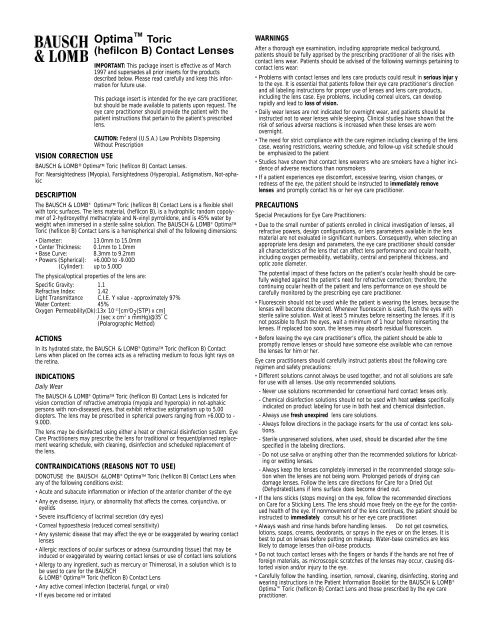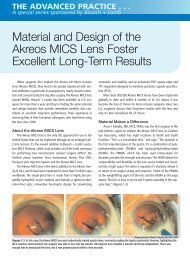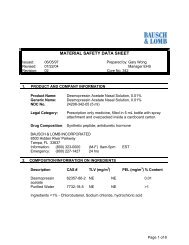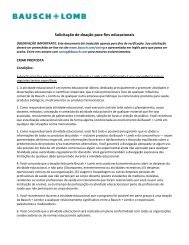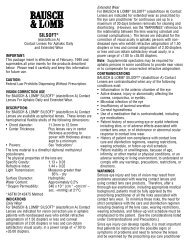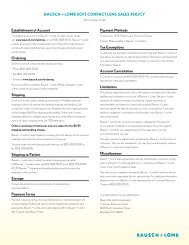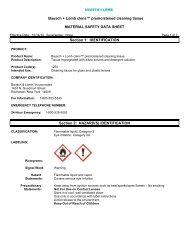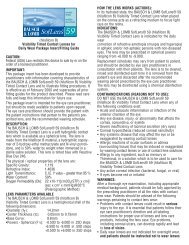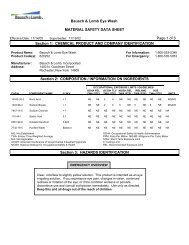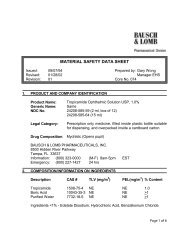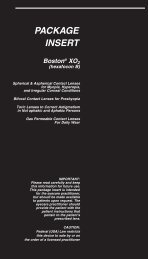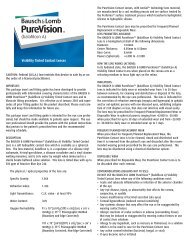(hefilcon B) Contact Lenses - Bausch + Lomb
(hefilcon B) Contact Lenses - Bausch + Lomb
(hefilcon B) Contact Lenses - Bausch + Lomb
You also want an ePaper? Increase the reach of your titles
YUMPU automatically turns print PDFs into web optimized ePapers that Google loves.
VISION CORRECTION USE<br />
BAUSCH & LOMB ® Optima TM Toric (<strong>hefilcon</strong> B) <strong>Contact</strong> <strong>Lenses</strong>.<br />
For: Nearsightedness (Myopia), Farsightedness (Hyperopia), Astigmatism, Not-aphakic<br />
DESCRIPTION<br />
The BAUSCH & LOMB ® Optima TM Toric (<strong>hefilcon</strong> B) <strong>Contact</strong> Lens is a flexible shell<br />
with toric surfaces. The lens material, (<strong>hefilcon</strong> B), is a hydrophilic random copolymer<br />
of 2-hydroxyethyl methacrylate and N-vinyl pyrrolidone, and is 45% water by<br />
weight when immersed in a sterile saline solution. The BAUSCH & LOMB ® Optima TM<br />
Toric (<strong>hefilcon</strong> B) <strong>Contact</strong> Lens is a hemispherical shell of the following dimensions:<br />
• Diameter: 13.0mm to 15.0mm<br />
• Center Thickness: 0.1mm to 1.0mm<br />
• Base Curve: 8.3mm to 9.2mm<br />
• Powers (Spherical): +6.00D to -9.00D<br />
(Cylinder): up to 5.00D<br />
The physical/optical properties of the lens are:<br />
Specific Gravity: 1.1<br />
Refractive Index: 1.42<br />
Light Transmittance C.I.E. Y value - approximately 97%<br />
Water Content: 45%<br />
Oxygen Permeability(Dk):13x 10 –11 [cm 3 O 2 (STP) x cm]<br />
/ (sec x cm 2 x mmHg)@35˚ C<br />
(Polarographic Method)<br />
ACTIONS<br />
In its hydrated state, the BAUSCH & LOMB ® Optima TM Toric (<strong>hefilcon</strong> B) <strong>Contact</strong><br />
Lens when placed on the cornea acts as a refracting medium to focus light rays on<br />
the retina.<br />
INDICATIONS<br />
Daily Wear<br />
Optima Toric<br />
(<strong>hefilcon</strong> B) <strong>Contact</strong> <strong>Lenses</strong><br />
IMPORTANT: This package insert is effective as of March<br />
1997 and supersedes all prior inserts for the products<br />
described below. Please read carefully and keep this information<br />
for future use.<br />
This package insert is intended for the eye care practitioner,<br />
but should be made available to patients upon request. The<br />
eye care practitioner should provide the patient with the<br />
patient instructions that pertain to the patient’s prescribed<br />
lens.<br />
CAUTION: Federal (U.S.A.) Law Prohibits Dispensing<br />
Without Prescription<br />
The BAUSCH & LOMB ® Optima TM Toric (<strong>hefilcon</strong> B) <strong>Contact</strong> Lens is indicated for<br />
vision correction of refractive ametropia (myopia and hyperopia) in not-aphakic<br />
persons with non-diseased eyes, that exhibit refractive astigmatism up to 5.00<br />
diopters. The lens may be prescribed in spherical powers ranging from +6.00D to -<br />
9.00D.<br />
The lens may be disinfected using either a heat or chemical disinfection system. Eye<br />
Care Practitioners may prescribe the lens for traditional or frequent/planned replacement<br />
wearing schedule, with cleaning, disinfection and scheduled replacement of<br />
the lens.<br />
CONTRAINDICATIONS (REASONS NOT TO USE)<br />
DONOTUSE the BAUSCH &LOMB ® Optima TM Toric (<strong>hefilcon</strong> B) <strong>Contact</strong> Lens when<br />
any of the following conditions exist:<br />
• Acute and subacute inflammation or infection of the anterior chamber of the eye<br />
• Any eye disease, injury, or abnormality that affects the cornea, conjunctiva, or<br />
eyelids<br />
• Severe insufficiency of lacrimal secretion (dry eyes)<br />
• Corneal hypoesthesia (reduced corneal sensitivity)<br />
• Any systemic disease that may affect the eye or be exaggerated by wearing contact<br />
lenses<br />
• Allergic reactions of ocular surfaces or adnexa (surrounding tissue) that may be<br />
induced or exaggerated by wearing contact lenses or use of contact lens solutions<br />
• Allergy to any ingredient, such as mercury or Thimerosal, in a solution which is to<br />
be used to care for the BAUSCH<br />
& LOMB ® Optima TM Toric (<strong>hefilcon</strong> B) <strong>Contact</strong> Lens<br />
• Any active corneal infection (bacterial, fungal, or viral)<br />
• If eyes become red or irritated<br />
WARNINGS<br />
After a thorough eye examination, including appropriate medical background,<br />
patients should be fully apprised by the prescribing practitioner of all the risks with<br />
contact lens wear. Patients should be advised of the following warnings pertaining to<br />
contact lens wear:<br />
• Problems with contact lenses and lens care products could result in serious injur y<br />
to the eye. It is essential that patients follow their eye care practitioner’s direction<br />
and all labeling instructions for proper use of lenses and lens care products,<br />
including the lens case. Eye problems, including corneal ulcers, can develop<br />
rapidly and lead to loss of vision.<br />
• Daily wear lenses are not indicated for overnight wear, and patients should be<br />
instructed not to wear lenses while sleeping. Clinical studies have shown that the<br />
risk of serious adverse reactions is increased when these lenses are worn<br />
overnight.<br />
• The need for strict compliance with the care regimen including cleaning of the lens<br />
case, wearing restrictions, wearing schedule, and follow-up visit schedule should<br />
be emphasized to the patient<br />
• Studies have shown that contact lens wearers who are smokers have a higher incidence<br />
of adverse reactions than nonsmokers<br />
• If a patient experiences eye discomfort, excessive tearing, vision changes, or<br />
redness of the eye, the patient should be instructed to immediately remove<br />
lenses and promptly contact his or her eye care practitioner.<br />
PRECAUTIONS<br />
Special Precautions for Eye Care Practitioners:<br />
• Due to the small number of patients enrolled in clinical investigation of lenses, all<br />
refractive powers, design configurations, or lens parameters available in the lens<br />
material are not evaluated in significant numbers. Consequently, when selecting an<br />
appropriate lens design and parameters, the eye care practitioner should consider<br />
all characteristics of the lens that can affect lens performance and ocular health,<br />
including oxygen permeability, wettability, central and peripheral thickness, and<br />
optic zone diameter.<br />
• The potential impact of these factors on the patient’s ocular health should be carefully<br />
weighed against the patient’s need for refractive correction; therefore, the<br />
continuing ocular health of the patient and lens performance on eye should be<br />
carefully monitored by the prescribing eye care practitioner.<br />
• Fluorescein should not be used while the patient is wearing the lenses, because the<br />
lenses will become discolored. Whenever fluorescein is used, flush the eyes with<br />
sterile saline solution. Wait at least 5 minutes before reinserting the lenses. If it is<br />
not possible to flush the eyes, wait a minimum of 1 hour before reinserting the<br />
lenses. If replaced too soon, the lenses may absorb residual fluorescein.<br />
• Before leaving the eye care practitioner’s office, the patient should be able to<br />
promptly remove lenses or should have someone else available who can remove<br />
the lenses for him or her.<br />
Eye care practitioners should carefully instruct patients about the following care<br />
regimen and safety precautions:<br />
• Different solutions cannot always be used together, and not all solutions are safe<br />
for use with all lenses. Use only recommended solutions.<br />
• - Never use solutions recommended for conventional hard contact lenses only.<br />
• - Chemical disinfection solutions should not be used with heat unless specifically<br />
indicated on product labeling for use in both heat and chemical disinfection.<br />
• - Always use fresh unexpired lens care solutions.<br />
• - Always follow directions in the package inserts for the use of contact lens solutions.<br />
• - Sterile unpreserved solutions, when used, should be discarded after the time<br />
specified in the labeling directions.<br />
• - Do not use saliva or anything other than the recommended solutions for lubricating<br />
or wetting lenses.<br />
• - Always keep the lenses completely immersed in the recommended storage solution<br />
when the lenses are not being worn. Prolonged periods of drying can<br />
damage lenses. Follow the lens care directions for Care for a Dried Out<br />
(Dehydrated)Lens if lens surface does become dried out.<br />
• If the lens sticks (stops moving) on the eye, follow the recommended directions<br />
on Care for a Sticking Lens. The lens should move freely on the eye for the continued<br />
health of the eye. If nonmovement of the lens continues, the patient should be<br />
instructed to immediately consult his or her eye care practitioner.<br />
• Always wash and rinse hands before handling lenses. Do not get cosmetics,<br />
lotions, soaps, creams, deodorants, or sprays in the eyes or on the lenses. It is<br />
best to put on lenses before putting on makeup. Water-base cosmetics are less<br />
likely to damage lenses than oil-base products.<br />
• Do not touch contact lenses with the fingers or hands if the hands are not free of<br />
foreign materials, as microscopic scratches of the lenses may occur, causing distorted<br />
vision and/or injury to the eye.<br />
• Carefully follow the handling, insertion, removal, cleaning, disinfecting, storing and<br />
wearing instructions in the Patient Information Booklet for the BAUSCH & LOMB ®<br />
Optima Toric (<strong>hefilcon</strong> B) <strong>Contact</strong> Lens and those prescribed by the eye care<br />
practitioner.
• Never wear lenses beyond the period recommended by the eye care practitioner.<br />
• If aerosol products such as hair spray are used while wearing lenses, exercise<br />
caution and keep eyes closed until the spray has settled.<br />
• Always handle lenses gently and avoid dropping them.<br />
• Avoid all harmful or irritating vapors and fumes while wearing lenses.<br />
• Ask the eye care practitioner about wearing lenses during water activities and other<br />
sports.<br />
• Inform the doctor (health care practitioner) about being a contact lens wearer.<br />
• Never use tweezers or other tools to remove lenses from the lens container unless<br />
specifically indicated for that use. Pour the lens into the hand.<br />
• Do not touch the lens with fingernails.<br />
• Always discard lenses and lenses worn on a frequent/planned replacement wearing<br />
schedule after the recommended wearing schedule prescribed by the eye care<br />
practitioner.<br />
• Always contact the eye care practitioner before using any medicine in the eyes.<br />
• Always inform the employer of being a contact lens wearer. Some jobs may require<br />
use of eye protection equipment or may require that the patient not wear contact<br />
lenses.<br />
• As with any contact lens, follow-up visits are necessary to assure the continuing<br />
health of the patient’s eyes. The patient should be instructed as to a recommended<br />
follow-up schedule.<br />
ADVERSE REACTIONS<br />
The patient should be informed that the following problems may occur:<br />
• Eye stinging, burning, itching (irritation), or other eye pain<br />
• Comfort is less than when lens was first placed on eye<br />
• Abnormal feeling of something in the eye (foreign body, scratched area)<br />
• Excessive watering (tearing) of the eyes<br />
• Unusual eye secretions<br />
• Redness of the eyes<br />
• Reduced sharpness of vision (poor visual acuity)<br />
• Blurred vision, rainbows, or halos around objects<br />
• Sensitivity to light (photophobia)<br />
• Dry eyes<br />
If the patient notices any of the above, he or she should be instructed to:<br />
• Immediately remove lenses.<br />
• If the discomfort or problem stops, then look closely at the lens. If the lens is in<br />
any way damaged, do not put the lens back on the eye. Place the lens in the<br />
storage case and contact the eye care practitioner. If the lens has dirt, an eyelash,<br />
or other foreign body on it, or the problem stops and the lens appears undamaged,<br />
the patient should thoroughly clean, rinse, and disinfect the lenses; then reinsert<br />
them. After reinsertion, if the problem continues, the patient should immediately<br />
remove the lenses and consult the eye care practitioner .<br />
If the above symptoms continue after removal of the lens, or upon reinsertion of a<br />
lens, or upon insertion of a new lens, the patient should immediately remove the<br />
lens and contact his or her eye care practitioner or physician, who must determine<br />
the need for examination, treatment or referral without delay. (See Important<br />
Treatment Information for Adverse Reactions.) A serious condition such as infection,<br />
corneal ulcer, corneal vascularization, or iritis may be present, and may progress<br />
rapidly. Less serious reations such as abrasions, epithelial stinging or bacterial conjunctivitis<br />
must be managed and treated carefully to avoid more serious complications.<br />
Important Treatment Information for Adverse Reactions<br />
Sight-threatening ocular complications associated with contact lens wear can<br />
develop rapidly, and therefore early recognition and treatment of problems are critical.<br />
Infectious corneal ulceration is one of the most serious potential complications,<br />
and may be amibiguous in its early stage. Signs and symptoms of infectious corneal<br />
ulceration include discomfort, pain, inflammation, purulent discharge, sensitivity to<br />
light, cells and flare and corneal infiltrates.<br />
Initial symptoms of a minor abrasion and an early infected ulcer are sometimes<br />
similar. Accordingly, such epithelial defect, if not treated properly, may develop into<br />
an infected ulcer. In order to prevent serious progression of these conditions, a<br />
patient presenting symptoms of abrasions or early ulcers should be evaluated as a<br />
potential medical emergency, treated accordingly, and be referred to a corneal specialist<br />
when appropriate. Standard therapy for corneal abrasions such as eye patching<br />
or the use of steroids or steroid/antibiotic combinations may exacerbate the condition.<br />
If the patient is wearing a contact lens on the affected eye when examined,<br />
the lens should be removed immediately and the lens and lens care products<br />
retained for analysis and culturing.<br />
FITTING<br />
Conventional methods of fitting contact lenses apply to BAUSCH & LOMB ® Optima<br />
Toric (<strong>hefilcon</strong>B) <strong>Contact</strong> <strong>Lenses</strong>. It is very important for the eye care practitioner to<br />
give the patient the Patient Information booklet for Optima Toric (<strong>hefilcon</strong>B)<br />
<strong>Contact</strong> <strong>Lenses</strong> and review it with the patient. For a detailed description of the fitting<br />
techniques, refer to the BAUSCH & LOMB ® Optima Toric (<strong>hefilcon</strong> B) <strong>Contact</strong> Lens<br />
Professional Fitting and Information Guide, copies of which are available from:<br />
<strong>Bausch</strong> &<strong>Lomb</strong> Incorporated<br />
Rochester, New York 14692<br />
Toll Free Telephone Number<br />
In the Continental U.S., Alaska, Hawaii<br />
1-800-828-9030<br />
In New York State<br />
1-800-462-1720<br />
WEARING SCHEDULE<br />
It is recommended that contact lens wearers see their eye care practitioner twice<br />
each year or if directed, more frequently.<br />
Daily Wear:<br />
There may be a tendency for the daily wear patient to over wear the lenses initially.<br />
Therefore, the importance of adhering to a proper, initial daily wearing schedule<br />
should be stressed to these patients.<br />
The wearing schedule should be dertermined by the eye care practitioner. The<br />
wearing schedule chosen by the eye care practitioner should be provided to the<br />
patient.<br />
LENS CARE DIRECTIONS<br />
Eye care practitioners should review with the patient lens care directions, including<br />
both basic lens care information and specific instructions on the lens care regimen<br />
recommended for the patient:<br />
General Lens Care (To First Clean and Rinse, Then Disinfect <strong>Lenses</strong>)<br />
Basic Instructions:<br />
• Always wash, rinse, and dry hands before handling contact lenses.<br />
• Always use fresh unexpired lens care solutions.<br />
• Use the recommended system of lens care, either heat (thermal) or chemical (not<br />
heat) and carefully follow instructions on solution labeling. Different solutions<br />
cannot always be used together, and not all solutions<br />
are safe for use with all lenses. Do not alternate<br />
or mix lens care systems unless indicated on solution labeling.<br />
• Do not use saliva or anything other than the recommended solutions for lubricating<br />
or rewetting lenses. Do not put lenses in the mouth.<br />
• <strong>Lenses</strong> should be cleaned, rinsed, and disinfected each time they are removed.<br />
Cleaning and rinsing are necessary to remove mucus and film from the lens<br />
surface. Disinfecting is necessary to destroy harmful germs.<br />
• Always remove, clean, rinse, enzyme and disinfect lenses according to the schedule<br />
prescribed by the eye care practitioner. The use of an enzyme or any cleaning<br />
solution does not substitute for disinfection.<br />
LENS CARE PRODUCT CHART<br />
The following solutions are recommended by <strong>Bausch</strong> & <strong>Lomb</strong> for use with BAUSCH<br />
& L O M B ® Optima Toric (<strong>hefilcon</strong> B) <strong>Contact</strong> <strong>Lenses</strong>; however, eye care practitioners<br />
may recommend alternative products and procedures for their patients. All components<br />
necessary for lens disinfection, cleaning and storage are available in<br />
BAUSCH & LOMB ® Care Kits.<br />
Thermal Lens Care System<br />
Action Care Product<br />
Cleaning BAUSCH & LOMB ® SENSITIVE EYES ® Daily Cleaner<br />
Rinsing, Disinfecting<br />
& Storing Commercially available Heat Disinfection Unit for <strong>Contact</strong><br />
<strong>Lenses</strong> used with:<br />
BAUSCH & LOMB ® ReNu ® Saline Solution<br />
BAUSCH & LOMB ® SENSITIVE EYES ® Sterile Saline Spray<br />
BAUSCH & LOMB ® SENSITIVE EYES ® Saline Solution<br />
BAUSCH & LOMB ® SENSITIVE EYES ® Plus Saline Solution<br />
Enzymatic Protein BAUSCH & LOMB ® ReNu ® Thermal<br />
Removal Enzymatic <strong>Contact</strong> Lens Cleaner<br />
BAUSCH & LOMB ® ReNu ® Effervescent Enzymatic <strong>Contact</strong><br />
Lens Cleaner<br />
BAUSCH & LOMB ® SENSITIVEEYES ®<br />
Enzymatic <strong>Contact</strong> Lens Cleaner<br />
Chemical Lens Care System<br />
Action Care Product<br />
Cleaning BAUSCH & LOMB ® ReNu ® Multi-<br />
Purpose Solution<br />
BAUSCH & LOMB ® SENSITIVE EYES ®<br />
Daily Cleaner
Disinfecting & BAUSCH & LOMB ® ReNu ® Multi-<br />
Storing Purpose Solution<br />
Rinsing BAUSCH & LOMB ® ReNu ® Multi-<br />
Purpose Solution<br />
BAUSCH & LOMB ® SENSITIVE EYES ®<br />
Saline Solution<br />
BAUSCH & LOMB ® ReNu ® Saline<br />
Solution<br />
BAUSCH & LOMB ® SENSITIVE EYES ®<br />
Sterile Saline Spray<br />
BAUSCH & LOMB ® SENSITIVE EYES ®<br />
Plus Saline Solution<br />
Enzymatic Protein BAUSCH & LOMB ® ReNu ®<br />
Removal Effervescent Enzymatic <strong>Contact</strong><br />
Lens Cleaner<br />
BAUSCH & LOMB ® SENSITIVEEYES ®<br />
Enzymatic <strong>Contact</strong> Lens Cleaner<br />
BAUSCH & LOMB ® ReNu ® 1 Step Enzymatic <strong>Contact</strong> Lens<br />
Cleaner<br />
All Lens Care Systems<br />
Action Care Product<br />
Rewetting BAUSCH & LOMB ® ReNu ®<br />
Rewetting Drops<br />
BAUSCH & LOMB ® SENSITIVE EYES ®<br />
Drops<br />
• Note: Some solutions may have more than one function, which will be indicated<br />
on the label. Read the label on the solution bottle, and follow instructions.<br />
• Clean one lens first (always the same lens first to avoid mixups), rinse the lens<br />
thoroughly with recommended saline or disinfecting solution to remove the cleaning<br />
solution, mucus, and film from the lens surface, and put that lens into the<br />
correct chamber of the lens storage case. Then repeat the procedure for the<br />
second lens.<br />
• After cleaning and rinsing, disinfect lenses using the system recommended by the<br />
manufacturer and/or the eye care practitioner.<br />
• To store lenses, disinfect and leave them in the closed/unopened case until ready<br />
to wear. If lenses are not to be used immediately after disinfection, you should<br />
consult the labeling of the storage solution for information on lens storage.<br />
• After removing the lenses from the lens case, empty and rinse the lens storage<br />
case with solution as recommended by the lens case manufacturer; then allow the<br />
lens case to air dry. When the case is used again, refill it with storage solution.<br />
Replace lens case at regular intervals.<br />
• Eye care practitioners may recommend a lubricating/rewetting solution which can<br />
be used to wet (lubricate) lenses while they are being worn to make them more<br />
comfortable.<br />
• <strong>Lenses</strong> prescribed in a frequent replacement program should be thrown away after<br />
the recommended wearing period prescribed by the practitioner.<br />
Heat (Thermal) Lens Disinfection:<br />
• After cleaning and thoroughly rinsing contact lenses with recommended solutions,<br />
prepare the empty lens storage case. To keep the lenses wet during disinfection,<br />
use the solution that is recommended by the lens manufacturer and/or the eye<br />
care practitioner.<br />
• Wet the lens chambers (sections) with fresh saline solution.<br />
• Put each lens into its correct chamber.<br />
• Fill the chamber of the case to the line with fresh saline solution. Completely cover<br />
the lenses.<br />
• Tightly close the top on each chamber of the lens storage case.<br />
• Put the lens storage case into the disinfection unit and follow the disinfection unit<br />
manufacturer’s directions for operating the unit (turning the unit on, assuring that<br />
it works, and leaving it on for a sufficient time to disinfect the lenses).<br />
• Before reinsertion of the lenses, no rinsing is necessary unless the eye care practitioner<br />
recommends rinsing.<br />
Emergency (Alternate) Method for Heat (Thermal) Disinfection:<br />
• If a heat disinfection unit is not available, place the tightly closed storage container<br />
which contains the lenses into a pan of already boiling water. Leave the closed lens<br />
case in the pan of boiling water for at least 10 minutes. (Above an altitude of 7,000<br />
feet, boil for at least 15 minutes.) Be careful not to allow the water in the pan to<br />
boil away. Remove the pan from the heat and allow it to cool for 30 minutes to<br />
complete the disinfection of the lens.<br />
Note: Use of heat disinfection unit should be resumed as soon as possible.<br />
• Leave the lenses in the unopened storage case until ready to put on the eyes.<br />
• Before reinsertion of the lenses, no rinsing is necessary unless the eye care practitioner<br />
recommends rinsing.<br />
Chemical (Not Heat) Disinfection:<br />
• Clean the contact lenses with a recommended cleaning solution and thoroughly<br />
rinse them with a recommended rinsing solution.<br />
• After cleaning and rinsing, to disinfect, carefully follow the instructions accompanying<br />
the disinfecting solution in the care regimen recommended by the lens manufacturer<br />
or the eye care practitioner.<br />
• When using hydrogen peroxide lens care systems, lenses must be neutralized<br />
before wearing. Follow the recommendations on the hydrogen peroxide system<br />
labeling.<br />
• Thoroughly rinse lenses with a fresh solution recommended for rinsing before<br />
inserting and wearing, or follow the instructions on the disinfection solution labeling.<br />
• Do not heat the disinfection solution and lenses.<br />
• Leave the lenses in the unopened storage case until ready to put on the eyes.<br />
• Caution: <strong>Lenses</strong> that are chemically disinfected may absorb ingredients from the<br />
disinfecting solution which may be irritating to the eyes. A thorough rinse in fresh<br />
sterile saline solution prior to placement on the eye should reduce the potential for<br />
irritation.<br />
LENS DEPOSITS AND USE OF ENZYMATIC<br />
CLEANING PROCEDURE<br />
Enzyme cleaning may be recommended by the eye care practitioner. Enzyme cleaning<br />
removes protein deposits on the lens. These deposits cannot be removed with<br />
regular cleaners. Removing protein deposits is important for the well-being of the<br />
patient’s lenses and eyes. If these deposits are not removed, they can damage the<br />
lenses and cause irritation.<br />
Enzyme cleaning does NOT replace routine cleaning and disinfecting. For enzyme<br />
cleaning, the patient should carefully follow the instructions in the enzymatic cleaning<br />
labeling.<br />
LENS CASE CLEANING AND MAINTENANCE<br />
<strong>Contact</strong> lens cases can be a source of bacteria growth. Lens cases should be<br />
emptied, cleaned, rinsed with solutions recommended by the lens case manufacturer,<br />
and allowed to air dry. Lens cases should be replaced at regular intervals.<br />
CARE FOR A DRIED OUT (DEHYDRATED) OR<br />
DRY LENS<br />
If a soft, hydrophilic contact lens is exposed to air while off the eye, it may become<br />
dry and brittle and need to be rehydrated. If the lens is adhering to a surface, such<br />
as a counter top, apply saline or rinsing solution before handling.<br />
To rehydrate the lens:<br />
• Handle the lens carefully.<br />
• Place the lens in its storage case and soak the lens in a recommended rinsing and<br />
storing solution for at least one hour until it returns to a soft state.<br />
• Clean and disinfect the rehydrated lens using a recommended lens care system.<br />
• If after soaking, the lens does not become soft, the lens should not be used until<br />
examined by the eye care practitioner.<br />
CARE FOR A STICKING (NONMOVING) LENS<br />
If the lens sticks (stops moving), the patient should be instructed to use a lubricating<br />
or rewetting solution in their eye. The patient should be instructed to not use<br />
plain water, or anything other than the recommended solutions. The patient should<br />
be instructed to contact the eye care practitioner if the lens does not begin to move<br />
upon blinking after several applications of the solution.<br />
PRACTITIONER FITTING SETS<br />
All lenses that have been opened must be disinfected after each fitting and at least once<br />
each week. Unopened lenses are sterile and need not be disinfected until the vial seal has<br />
been broken.<br />
EMERGENCIES<br />
The patient should be informed that if chemicals of any kind (household products,<br />
gardening solutions, laboratory chemicals, etc.) are splashed into the eyes, the<br />
patient should: FLUSH EYES IMMEDIATELY WITH TAP WATER AND THEN REMOVE<br />
LENSES PROMPTLY. CONTACT THE EYE CARE PRACTITIONER OR VISIT A HOSPI-<br />
TAL EMERGENCY ROOM WITHOUT DELAY.<br />
HOW SUPPLIED<br />
Each Optima Toric (<strong>hefilcon</strong> B) <strong>Contact</strong> Lens is supplied sterile in a glass vial containing<br />
bicarbonate buffered saline solution. The container is marked with the manufacturing<br />
lot number of the lens, the base curve, sphere power, cylinder power, axis,<br />
diameter and expiration date.
REPORTING OF ADVERSE REACTIONS<br />
All serious adverse experiences and adverse reactions observed in patients wearing<br />
BAUSCH & LOMB ®<br />
Optima Toric (<strong>hefilcon</strong> B) <strong>Contact</strong> <strong>Lenses</strong> or experienced with the lenses should<br />
be reported to:<br />
<strong>Bausch</strong> &<strong>Lomb</strong> Incorporated<br />
Rochester, New York 14692<br />
Toll Free Telephone Number<br />
In the Continental U.S., Alaska, Hawaii<br />
1-800-828-9030<br />
In New York State<br />
1-800-462-1720<br />
<strong>Bausch</strong> & <strong>Lomb</strong> Incorporated<br />
Rochester, NY 14692<br />
© <strong>Bausch</strong> & <strong>Lomb</strong> Incorporated. All rights reserved worldwide.<br />
BAUSCH & LOMB, OPTIMA, SENSTITIVE EYES, and ReNu are trademarks of <strong>Bausch</strong> & <strong>Lomb</strong><br />
Incorporated.<br />
WARNING: Manufactured with CFC-113, a substance which harms public health and environment by destroying ozone<br />
in the upper atmosphere.<br />
DPI0003 03/97 Printed in U.S.A.


